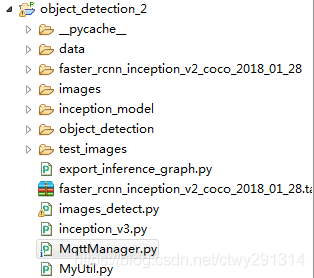本章主要内容是利用mqtt、多线程、队列实现模型一次加载,批量图片识别分类功能
目录结构如下:

mqtt连接及多线程队列管理
# -*- coding:utf8 -*-
import paho.mqtt.client as mqtt
from multiprocessing import Process, Queue
import images_detect
MQTTHOST = "192.168.3.202"
MQTTPORT = 1883
mqttClient = mqtt.Client()
q = Queue()
# 连接MQTT服务器
def on_mqtt_connect():
mqttClient.connect(MQTTHOST, MQTTPORT, 60)
mqttClient.loop_start()
# 消息处理函数
def on_message_come(mqttClient, userdata, msg):
q.put(msg.payload.decode("utf-8")) # 放入队列
print("产生消息", msg.payload.decode("utf-8"))
def consumer(q, pid):
print("开启消费序列进程", pid)
# 多进程中发布消息需要重新初始化mqttClient
ImagesDetect = images_detect.ImagesDetect()
ImagesDetect.detect(q)
# subscribe 消息订阅
def on_subscribe():
mqttClient.subscribe("test", 1) # 主题为"test"
mqttClient.on_message = on_message_come # 消息到来处理函数
# publish 消息发布
def on_publish(topic, msg, qos):
mqttClient.publish(topic, msg, qos);
def main():
on_mqtt_connect()
on_subscribe()
for i in range(1, 3):
c1 = Process(target=consumer, args=(q, i))
c1.start()
while True:
pass
if __name__ == '__main__':
main()
图片识别
images_detect.py
# coding: utf-8
import numpy as np
import os
import sys
import tarfile
import tensorflow as tf
from object_detection.utils import label_map_util
from object_detection.utils import visualization_utils as vis_util
import cv2
import decimal
import MyUtil
context = decimal.getcontext()
context.rounding = decimal.ROUND_05UP
class ImagesDetect():
def __init__(self):
sys.path.append("..")
MODEL_NAME = 'faster_rcnn_inception_v2_coco_2018_01_28'
MODEL_FILE = MODEL_NAME + '.tar.gz'
# Path to frozen detection graph. This is the actual model that is used for the object detection.
PATH_TO_CKPT = MODEL_NAME + '/frozen_inference_graph.pb'
# List of the strings that is used to add correct label for each box.
PATH_TO_LABELS = os.path.join('data', 'mscoco_label_map.pbtxt')
NUM_CLASSES = 90
tar_file = tarfile.open(MODEL_FILE)
for file in tar_file.getmembers():
file_name = os.path.basename(file.name)
if 'frozen_inference_graph.pb' in file_name:
tar_file.extract(file, os.getcwd())
# ## Load a (frozen) Tensorflow model into memory.
self.detection_graph = tf.Graph()
with self.detection_graph.as_default():
od_graph_def = tf.GraphDef()
with tf.gfile.GFile(PATH_TO_CKPT, 'rb') as fid:
serialized_graph = fid.read()
od_graph_def.ParseFromString(serialized_graph)
tf.import_graph_def(od_graph_def, name='')
# ## Loading label map
# Label maps map indices to category names, so that when our convolution network predicts `5`, we know that this corresponds to `airplane`. Here we use internal utility functions, but anything that returns a dictionary mapping integers to appropriate string labels would be fine
label_map = label_map_util.load_labelmap(PATH_TO_LABELS)
categories = label_map_util.convert_label_map_to_categories(label_map, max_num_classes=NUM_CLASSES, use_display_name=True)
self.category_index = label_map_util.create_category_index(categories)
self.image_tensor = self.detection_graph.get_tensor_by_name('image_tensor:0')
# 每个框代表一个物体被侦测到
self.boxes = self.detection_graph.get_tensor_by_name('detection_boxes:0')
# 每个分值代表侦测到物体的可信度.
self.scores = self.detection_graph.get_tensor_by_name('detection_scores:0')
self.classes = self.detection_graph.get_tensor_by_name('detection_classes:0')
self.num_detections = self.detection_graph.get_tensor_by_name('num_detections:0')
def detect(self, q):
with self.detection_graph.as_default():
config = tf.ConfigProto()
# config.gpu_options.allow_growth = True
config.gpu_options.per_process_gpu_memory_fraction = 0.2
with tf.Session(graph=self.detection_graph, config=config) as sess:
while True:
img_src = q.get()
print('------------start------------' + MyUtil.get_time_stamp())
image_np = cv2.imread(img_src)
# 扩展维度,应为模型期待: [1, None, None, 3]
image_np_expanded = np.expand_dims(image_np, axis=0)
# 执行侦测任务.
(boxes, scores, classes, num_detections) = sess.run(
[self.boxes, self.scores, self.classes, self.num_detections],
feed_dict={self.image_tensor: image_np_expanded})
# 检测结果的可视化
vis_util.visualize_boxes_and_labels_on_image_array(
image_np,
np.squeeze(boxes),
np.squeeze(classes).astype(np.int32),
np.squeeze(scores),
self.category_index,
use_normalized_coordinates=True,
line_thickness=8)
print('------------end------------' + MyUtil.get_time_stamp())
# cv2.imshow('object detection', cv2.resize(image_np, (800, 600)))
if cv2.waitKey(25) & 0xFF == ord('q'):
cv2.destroyAllWindows()
break
import time
def get_time_stamp():
ct = time.time()
local_time = time.localtime(ct)
data_head = time.strftime("%Y-%m-%d %H:%M:%S", local_time)
data_secs = (ct - int(ct)) * 1000
time_stamp = "%s.%03d" % (data_head, data_secs)
return time_stamp
效果:
